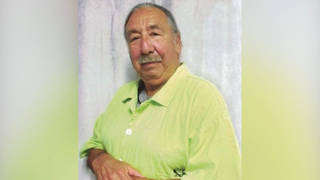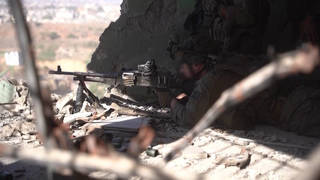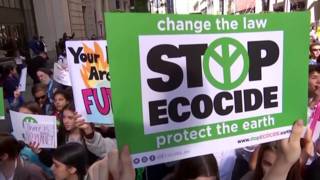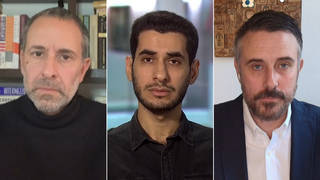
Related
Topics
Guests
- Tristan Scottreporter for the Missoulian. He has been covering the W.R. Grace trial.
- Andrea Peacockindependent journalist who has covered Montana politics and western environmental news for several years. She is a former editor of the Missoula Independent and has written for CounterPunch and Mother Jones. She is the author of Libby, Montana: Asbestos and the Deadly Silence of an American Corporation.
Government prosecutors called their final witness on Monday in their case against W.R. Grace and Company. The firm and five former executives are charged with knowingly exposing their workers and the public to vermiculite ore contaminated with asbestos from the company’s mine in Libby, Montana. The government has called it “the nation’s biggest environmental disaster.” Hundreds died as a result. W.R. Grace knew from the time it bought the mine in 1963 why the people in Libby were dying. But for the thirty years it owned the mine, the company did not stop it. We speak with two reporters covering the story. [includes rush transcript]
Transcript
AMY GOODMAN:
We’re on the road in Missoula, Montana, in our continued “Community Voices, Community Media” tour. Joining us here in Missoula, Tristan Scott, reporter for the Missoulian newspaper. He’s been covering the W.R. Grace trial. And Andrea Peacock is also with us. She’s an independent journalist who has covered Montana politics and western environmental news for several years. She is a former editor of the Missoula Independent and has written for CounterPunch and Mother Jones. She’s the author of the book Libby, Montana: Asbestos and the Deadly Silence of an American Corporation.
We welcome you both to Democracy Now! Tristan, tell us about this trial. There was a moment there when Gayla Benefield says she fears it’s a sham.
TRISTAN SCOTT:
Well, the trial has now been going on for two months, and in that time the government — we’re at the halfway point now — the government has essentially presented its case and called its last witness. And what they’ve done really effectively is to show the extent of Grace’s knowledge and these high-ranking officials, what they knew about the dangers of Libby asbestos. They presented reams of insider corporate memos to jurors showing that these defendants exchanged — had conversations about just how toxic these Libby asbestos fibers were, the propensity for the vermiculite they mined in Libby to break apart and release fibers into the ambient air. And I think they’ve done an effective job showing jurors that.
That said, what they’re charging is a conspiracy under the Clean Air Act, under a criminal provision that didn’t exist until 1990, which is the same year that the mine closed. So that’s what’s so far-reaching about this case, is that they’re trying to show that the conspiracy was furthered past 1990. That’s been very difficult for them. And, of course, they’re out-lawyered by corporate defense lawyers that — each defendant has a half-dozen lawyers working for them. So it has been — taken a left turn for the prosecution recently.
AMY GOODMAN:
Andrea, you have been following the story for a long time. You wrote a book on Libby, Montana. Talk about the significance of this, what you’ve seen, the defense and the prosecution, how they’re presenting the story, and what you think is key for people to know. I mean, I was so struck by Gayla Benefield saying they couldn’t get reporters in their own state, right here in Montana, for years to cover the crisis in Libby, Montana.
ANDREA PEACOCK:
That’s true, and I think part of it is just because Libby is so isolated physically. It’s up in the northwestern corner of the state, nothing much else around it.
The thing I think — there’s a couple things I think are key. One is, if a trial is about each side’s performance, each lawyer’s performance, and how well they tell their story, clearly, the defense has done a better job here. And you’re talking about very well-paid defense attorneys versus public servants on the government’s side. But if you go back and actually look at the elements of each charge, I think all the pieces are there. The government really has presented evidence for every single count and all the elements of those counts. And when the judge considers the motion to acquit next week, he has to view that evidence in the most favorable light to the government and decide whether or not a reasonable person would find, possibly find, guilt there. So I think chances are good that it’s actually going to go to a jury.
An interesting point, which a lot of people don’t realize, is that this trial really is about environmental crimes. It’s not about, you know, homicide, for instance. It’s about violations of the Clean Air Act and conspiracy and fraud and obstruction of justice. And it would be really interesting, I think, if our state attorney general at some point would reopen the question of homicide — certainly the difficulty is proving intent — but negligent homicide, you know, that Grace left this material in Libby, all over the place in Libby, knowing that it was far more toxic than other kinds of asbestos and also knowing that it is very easily disturbed, that the people in Libby just going about their day-to-day lives would stir this stuff up without intending to. So I think there’s definitely a case to be made there.
AMY GOODMAN:
Andrea, what did W.R. Grace know, and when did they know it, according to your research?
ANDREA PEACOCK:
Well, Grace knew before they bought the mine in 1963 that there was asbestos there. It was actually a draw. They thought they might be able to find some sort of commercial use, that they might be able to make a product and sell it. And the fibers in Libby turned out to be, I think, not strong enough, and so it was basically just a contaminant.
The company that owned the mine before Grace bought it had begun doing annual x-rays of their workforce and also lung function tests, and this was something that Grace continued year after year after year, so you can look at these memos and basically see the disease progression among, you know, named men. It’s really — it’s very disturbing.
Beginning in the 1970s, there was a toxicity test done on hamsters that compared Libby’s vermiculite, Libby’s asbestos, to other kinds of asbestos, and the Libby part of the study was not published at that time, that showed that Libby’s asbestos was far more virulent than other kinds of asbestos. And on into the ’80s, there were epidemiological studies. So, you know, certainly, it was widely known in ’63, when Grace bought the mine, that asbestos would kill you from asbestosis. The industry was well aware, though it was few years before it was widely known that there was a link to cancer. But by the ’70s, Grace knew even more that its particular product, not just the ore that, you know, the men were exposed to and the folks who lived in Libby, but also this product that went all over the United States and all over the world, was toxic.
And so, one of the defense’s most effective arguments has been, well, the government knew there was asbestos at the mine. People in Libby didn’t know, by the way. The first communication I came across in my research was 1979. There was some communication between a Mine Safety Health Administration inspector and the union president. But so the people in Libby didn’t know. And what the government didn’t know, neither the federal government or the state, was the degree of toxicity involved.
AMY GOODMAN:
How dirty is Libby today?
ANDREA PEACOCK:
That’s an open question. The EPA, back in 2002, thought they could get the town cleaned up in three years, and that’s obviously not happened. They’re still working through a backlog of properties that need to be cleaned. And then there’s the question of whether or not the cleanup itself has been effective. It’s proven very difficult to get it all out.
AMY GOODMAN:
Tristan, what have you been most struck by in this trial?
TRISTAN SCOTT:
Well, I definitely saw the jurors react most to the testimony from a doctor who has worked at the Center for Asbestos-Related Disease in Libby, and he testified that he has diagnosed 1,800 Libby residents with varying degrees of asbestos-related disease and that he continues to do so at a rate of about one per week. He also testified that a number — that most of these new diagnoses, that two-thirds of them are non-occupational exposures. So these are community members who contracted the disease by playing in piles of vermiculite; running on the high school track, which Grace used vermiculite in for the foundation; playing on the little league fields where vermiculite was used to absorb water in the outfield and used to line the base paths. And so, I think when the jurors are hearing about people, regular community members, being sickened by these mining activities and then by continued exposures just through normal everyday human activities, I think that that’s been some of the most effective and impactful testimony.
AMY GOODMAN:
I want to thank you both for being with us. Tristan Scott, a reporter for the Missoulian newspaper, he’s been covering the W.R. Grace trial. And Andrea Peacock, independent journalist, covered Montana politics and western environmental news for a number of years, is a former editor of the Missoula Independent. Her latest book is Libby, Montana: Asbestos and the Deadly Silence of an American Corporation. We thank you both for being with us.












Media Options